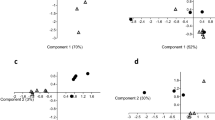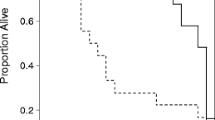Summary
Host selection by phytophagous insects is generally thought to be based on chemical or nutritional characteristics of the host. This is especially true for monophagous insects. However, many other factors may influence host choice. The present study examines host selection by Drosophila magnaquinaria, whose sole host is the yellow skunk cabbage, Lysichitum americanum. Utilization of skunk cabbage was tested relative to a set of alternative hosts. In the pre-alighting stage of host selection, skunk cabbage was found to be less attractive than tomato, cucumber, and commercial mushrooms. In pairwise oviposition tests, there were no differences among hosts. There were no differences in larval survivorship among skunk cabbage, tomato, cucumber, or Ramaria, and larvae developed into pupae earlier on tomato than on skunk cabbage. These results indicate that this monophagy is not based on characteristics of the host. We suggest that habitat selection is the more important factor in determining the association between D. magnaquinaria and skunk cabbage.
Similar content being viewed by others
References
Bernays EA, Graham M (1988) On the evolution of host specificity in phytophagous arthropods. Ecology 69:886–892
Bush GL (1969) Sympatric host race formation and speciation in frugivorous flies of the genus Rhagoletis (Diptera: Tephritidae). Evolution 23:237–251
Bush GL (1975) Sympatric speciation in phytophagous parasitic insects. In: Price PW (ed) Eyolutionary Strategies of Parasitic Insects and Mites. Plenum, New York, pp 187–206
Colwell RK (1986) Population structure and sexual selection for host fidelity in the speciation of hummingbird flower mites. In: Karlin S, Nevo E (eds) Evolutionary Process and Theory. Academic Press New York, pp 475–495
Connell JH (1980) Diversity and the coevolution of competitors, or the ghost of competition past. Oikos 35:131–138
Courtney SP (1982) Coevolution of pierid butterflies and their cruciferous foodplants. V. Habitat selection, community structure and speciation. Oecologia 54:101–107
Courtney SP, Chen GK (1988) Genetic and environmental variation in oviposition behavior in the mycophagous Drosophila suboccidentalis. Spcr Func Ecol 2:521–528
Courtney SP, Forsberg J (1988) Host use by two pierid butterflies varies with host density. Func Ecol 2:67–75
Courtney SP, Kibota TT (1990) Mother doesn't know best: selection of hosts by ovipositing insects. In: Bernays EA (ed) Plant-Insect Relationships, vol. 2. CRC Press, Boca Raton, Fl, pp 161–188
Courtney SP, Chen GK, Gardner A (1989) A general model for individual host selection. Oikos 35:55–65
Craig TP, Itami JK, Price PW (1989) A strong correlation between oviposition preference and larval performance in a shoot-galling sawfly. Ecology 70:1691–1699
Damman H (1987) Leaf quality and enemy avoidance by larvae of a pyralid moth. Ecology 68:87–97
Ehrlich PR, Raven PH (1964) Butterflies and plants: a study in coevolution. Evolution 18:586–608
Feeny PP (1976) Plant apparency and chemical defence. Rec Adv Phytochem 10:1–40
Fellows DP, Heed WB (1972) Factors affecting host plant selection in desert-adapted cactophilic Drosophila. Ecology 53:850–858
Fox LR, Morrow PA (1981) Specialization: species property or local phenomenon? Science 211:887–893
Futuyma DJ, Moreno G (1988) The evolution of ecological specialization. Annu Rev Ecol Syst 19:207–233
Futuyma DJ, Peterson SC (1985) Genetic variation in the use of resources by insects. Annu Rev Entomol 30:217–238
Futuyma DJ, Philippi TE (1987) Genetic variation and covariation in responses to host plants by Alsophila pometaria (Lepidoptera: Geometridae). Evolution 41:269–279
Grimaldi D (1985) Niche separation and competitive coexistence in mycophagous Drosophila (Diptera: Drosophilidae). Proc Entomol Soc Wash 87:498–511
Grimaldi D, Jaenike J (1984) Competition in natural populations of mycophagous Drosophila. Ecology 64:1113–1120
Hare JD, Kennedy GG (1986) Genetic variation in plant-insect associations: survival of Leptinotarsa decemlineata on Solanum carolinense. Evolution 40:345–361
Hitchcock CL, Cronquist A (1976) Flora of the Pacific Northwest: an Illustrated Manual. Univ. of Wash. Press, Seattle, Wa.
Hummel HK, van Delden W, Drent RH (1979) Estimation of some population parameters of Drosophila limbata V. Roser in a greenhouse. Oecologia 41:135–143
Jaenike J (1978) Resource predictability and niche breadth in the Drosophila quinaria species group. Evolution 32:676–678
Jaenike J (1983) Induction of host preference in Drosophila melanogaster. Oecologia 58:320–325
Jaenike J (1985) Parasite pressure and the evolution of amanitin tolerance in Drosophila. Evolution 39:1295–1301
Jaenike J (1988) Parasitism and mating success in Drosophila testacea. Am Nat 131:774–780
Jaenike J, Grimaldi D (1983) Genetic variation for host preference within and among populations of Drosophila tripunctata. Evolution 37:1023–1033
James AC, Jakubczak J, Riley MP, Jaenike J (1988) On the causes of monophagy in Drosophila quinaria. Evolution 42:626–630
Jermy T (1984) Evolution of insect-hostplant relationships. Am Nat 124:609–630
Kibota TT (1990) Jack of one trade, master of none: the ecology of Drosophila magnaquinaria. M.S. Thesis, Univ. of Oregon, Eugene, Or.
Kimura MT, Toda MJ (1989) Food preferences and nematode parasitism in mycophagous Drosophila. Ecol Res 4:209–218
Lawton JH (1978) Host-plant influences on insect diversity: the effects of space and time. Symp R Entomol Soc London 9:105–125
Lawton JH, Strong DR Jr (1981) Community patterns and competition in folivorous insects. Am Nat 118:317–338
Levene H (1953) Genetic equilibrium when more than one ecological niche is available. Am Nat 87:331–333
Lofdahl K (1986) A genetic analysis of habitat selection in the cactophilic species, Drosophila mojavensis. In: Huettel MD (ed) Evolutionary Genetics of Invertebrate Behavior. Plenum Press, New York, pp 153–163
MacArthur RH (1972) Geographical Ecology. Harper and Row, New York
Maynard Smith J, Hoekstra R (1980) Polymorphism in a varied environment: how robust are the models? Gen Res 35:45–57
Mitchell R (1975) The evolution of oviposition tactics in the bean weevil, Callosobruchus maculatus (F.). Ecology 56:696–702
Mitchell R (1983) Effects of host plant variability on the fitness of sedentary herbivorous insects. In: Denno RF, McClure MS (eds) Variable plants and herbivores in natural and managed systems. Academic Press, New York, pp 343–370
Mitter C, Farrell B (1991) Macroevolutionary patterns in insect-plant relationships. In: Bernays EA (ed) Insect-Plant Interactions, vol 3, CRC Press, Boca Raton, Fl
Montague JR, Jaenike J (1985) Nematode parasitism in natural populations of mycophagous drosophilids. Ecology 66:624–626
Myers JH (1985) Effect of physiological condition of the host plant on the oviposition choice of the cabbage white butterfly, Pieris rapae. J Anim Ecol 54:193–204
Ng D (1988) A novel level of interactions in plant-insect systems. Nature 334:611–612
Price PW, Roininen H, Tahvanainen J (1987a) Plant age and attack by the bud galler, Euura mucronata. Oecologia 73:334–337
Price PW, Roininen H, Tahvanainen J (1987b) Why does the bud galling sawfly, Euura mucronata, attack long shoots? Oecologia 74:1–6
Rausher MD (1984) Trade-offs in performance on different hosts: evidence from within- and between-site variation in the beetle Deloyala guttata. Evolution 38:582–595
Rausher MD, MacKay DA, Singer MC (1981) Pre- and post-alighting host discrimination by Euphydryas editha butterflies: the behavioral mechanisms causing clumped distributions of egg clusters. Anim Behav 29:1220–1228
Roininen H, Tahvanainen J (1989) Host selection and larval performance of two willow-feeding sawflies. Ecology 70:129–136
Scriber JM, Slansky F Jr (1981) The nutritional ecology of immature insects. Annu Rev Entomol 26:183–211
Shapiro AM (1971) Occurrence of latent polyphenism in Pieris virginiensis (Lep. Pieridae). Entomol New 82:13–16
Shorrocks B, Charlesworth P (1980) The distribution and abundances of the British fungal-feeding Drosophila. Ecol Entomol 5:61–78
Shuey JA, Peacock JW (1989) Host plant exploitation by an oligophagous population of Pieris virginiensis (Lepidoptera: Pieridae). Am Midl Nat 122:255–261
Singer MC (1986) The definition and measurement of oviposition preference in plant-feeding insects. In: Miller J, Miller TA (eds) Methods for Studying Mechanistic Interactions Between Insects and Plants. Springer, Berlin, pp 65–94
Singer MC, Ng D Thomas CD (1988) Heritability of oviposition preference and its relationship to offspring performance within a single insect population. Evolution 42:977–985
Slobodkin LB, Sanders HL (1969) On the contribution of environmental predictability to species diversity. In: Woodwell GM, Smith HH (eds) Diversity and Stability in Ecological Systems. Brookhaven National Laboratory, Upton New York, pp 82–95
Spieth HT (1987) The Drosophila fauna of a native California forest (Diptera: Drosophilidae). Pan-Pacific Entomologist 63:247–255
Spieth HT, Heed WB (1975) The Drosophila pinicola species group. Pan-Pacific Entomologist 51:287–295
Starmer WT (1981) A comparison of Drosophila habitats according to the physiological attributes of the associated yeast communities. Ecology 35:38–52
Strong DR, Lawton JH, Southwood TRE (1984) Insects on Plants. Blackwell, London
Thomas CD, Ng D, Singer MC, Mallet JLB, Parmesan C, Billington HL (1987) Incorporation of a European weed into the diet of a North American herbivore. Evolution 41:892–901
Thompson JN (1988) Evolutionary ecology of the relationship between oviposition preference and performance of offspring in phytophagous insects. Entomol Exp Appl 47:3–14
Toda MJ (1985a) Habitat structure of a drosophilid community at Inuvik, NWT, Canada (Diptera: Drosophilidae). Can Entomol 117:135–137
Toda MJ (1985b) Effects of the 1977 eruption of Mt. Usu on drosophilid flies. In August 1978. Jpn J Ecol 35:235–241
Via S (1984) The quantitative genetics of polyphagy in an insect herbivore. I. Genotype-environment interaction in larval performance on different plant species. Evolution 38:881–895
Via S (1986) Genetic covariance between oviposition preference and larval performance in an insect herbivore. Evolution 40:778–785
Wheeler MR (1954) V. Taxonomic studies on American Drosophilidae. Univ Tex Publ 544:47–64
Wiklund C (1975) The evolutionary relationship between adult oviposition preferences and larval host plant range in Papilio machaon. Oecologia 18:185–197
Whitham TG (1978) Habitat selection by Pemphigus aphids in response to resource limitation and competition. Ecology 59:1164–1176
Whitham TG (1980) The theory of habitat selection: examined and extended using Pemphigus aphids. Am Nat 115:449–466
Whitham TG (1986) Costs and benefits of territoriality: behavioral and reproductive release by competing aphids. Ecology 67:139–147
Worthen WR, McGuire TR (1988) A criticism of the aggregation model of coexistence of dipteran species on ephemeral resources. Am Nat 131:453–458
Author information
Authors and Affiliations
Rights and permissions
About this article
Cite this article
Kibota, T.T., Courtney, S.P. Jack of one trade, master of none: host choice by Drosophila magnaquinaria . Oecologia 86, 251–260 (1991). https://doi.org/10.1007/BF00317538
Received:
Accepted:
Issue Date:
DOI: https://doi.org/10.1007/BF00317538




